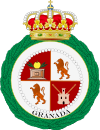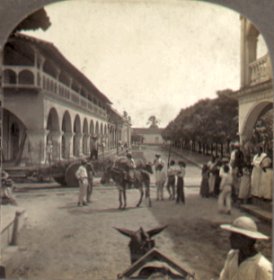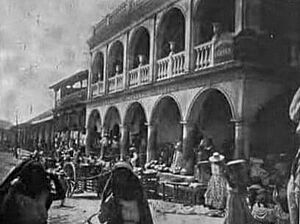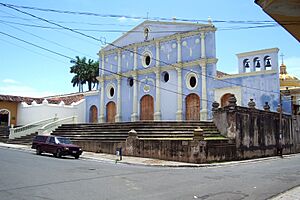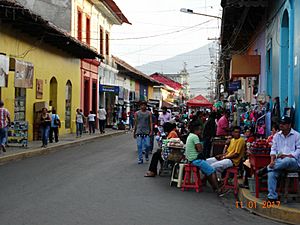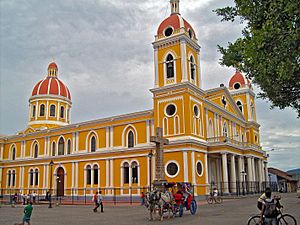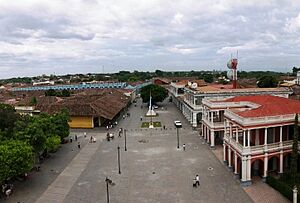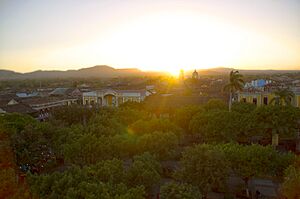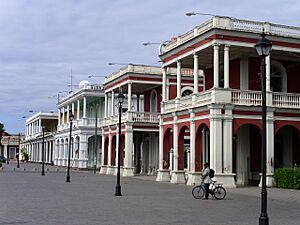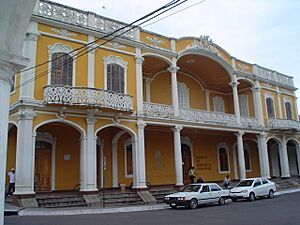Granada, Nicaragua facts for kids
Quick facts for kids
Granada
|
|||
|---|---|---|---|
|
Municipality
|
|||

La Catedral de Granada, seen from la Iglesia de la Merced
|
|||
|
|||
| Country | Nicaragua | ||
| Department | Granada Department | ||
| Founded | 1524 | ||
| Area | |||
| • Municipality | 229 sq mi (592 km2) | ||
| Population
(2022 estimate)
|
|||
| • Municipality | 134,104 | ||
| • Density | 586.7/sq mi (226.53/km2) | ||
| • Urban | 105,862 (9th Nicaragua) | ||
| Climate | Aw | ||
Granada (Spanish pronunciation: [ɡɾaˈnaða]) is a historic city in western Nicaragua. It is the capital of the Granada Department. About 105,862 people lived there in 2022. This makes it Nicaragua's ninth largest city.
Granada is very important to Nicaragua's history and economy. It has a rich past from the time of Spanish colonization. You can see this in its beautiful old buildings.
The city was founded in 1524 by Francisco Hernández de Córdoba. He named it after the city of Granada in Spain. It was one of the first European cities in mainland America.
Granada is also called La Gran Sultana. This nickname comes from its unique look, which reminds people of Moorish and Andalusian styles from Spain. It is different from its rival city, León, which has more Castilian influences.
Contents
History of Granada
The Spanish explorer Hernández de Córdoba founded Granada. He named it after the city of Granada in Spain. This was to celebrate the Spanish victory over the Emirate of Granada.
During the time of Spanish rule, Granada was a busy trading center. It traded goods with ports in the Atlantic Ocean. Ships used Lake Cocibolca and the San Juan River to reach the ocean.
Because it was so important, Granada was often attacked. English, French, and Dutch pirates tried to take control. They sailed up the San Juan River but did not succeed.
For many years, Granada and León competed to be the most important city in Nicaragua. Granada was supported by one political group, and León by another. This led to many conflicts between the cities.
In the mid-1800s, they agreed on a new capital city. Managua was chosen because it was located between both cities. This helped to end the long rivalry.

Granada was also involved in a strange part of history. An American adventurer named William Walker tried to take over Central America. He wanted to create new colonies based on slavery.
One of Walker's generals set Granada on fire before leaving. This destroyed many of the old colonial buildings. He even wrote "Here was Granada" on the ruins.
Granada was mostly peaceful during the Sandinista period in the 1970s and 1980s.
Geography and Nature
Granada is located right on the shore of Lake Nicaragua. This lake is also called Lake Cocibolca. It is the twentieth largest lake in the world.
Granada is the main city of the Granada Department. This area has many interesting natural features. The River Tipitapa connects Lake Managua and Lake Nicaragua here.
There are also three volcanic lagoons nearby. These are Manares, Genirzaro, and the famous Apoyo. Apoyo is the biggest volcanic lagoon in Nicaragua. It is shared with the Department of Masaya.
Granada is a very warm city all year. Its temperatures are similar to Managua. This is because it is close to a large lake and surrounded by hills. The city gets about 1,100 to 2,100 mm of rain each year. The average temperature is about 25.7 °C.
The plants and animals around Granada are shaped by its climate. Dry and humid forests grow around the Mombacho volcano. This volcano is home to many different animals.
Lake Nicaragua also has many unique creatures. It is the only freshwater lake in the world where sharks live. These are called Nicaragua sharks. Fishing is popular here, and people catch fish like guapote and mojarras. Nicaragua has recently stopped fishing for the Nicaragua shark and sawfish to protect them.
The Mombacho volcano is the highest point in Granada, at 1,345 meters. This volcano is now dormant. A long time ago, it blew much of its top into the lake. This created the 365 Islets of Granada. From these islets, you can get an amazing view of the volcano.
On a clear day, you can also see Ometepe and Zapatera Islands. Zapatera Island is the second largest island in Lake Nicaragua. It also has an inactive volcano. Ometepe Island is the largest. It is famous for its ancient statues and idols. These were found during the Spanish conquest. You can see them in museums and parks today.
Granada has many beaches on Lake Nicaragua. These beaches are very popular, especially during Semana Santa (Holy Week).
Economy and Tourism

Granada has always been a center for trade. It traded goods like timber, gold, and silver. Today, Granada's economy is growing because of tourism.
Granada is known for having some of the best-preserved colonial buildings in Nicaragua. Many people from Europe and America have bought and fixed up homes here. They use them for retirement or holidays.
New museums, hotels, and restaurants are opening quickly. This shows how much tourism is growing.
Even though tourism is important, Granada also has rich farmland. Farmers grow organic coffee and cacao. They also raise cattle and grow plantains and bananas.
Food and Dining
Granada's restaurants have been praised by international newspapers. The city has many places to eat, like Pita Pita and Garden Café.
In recent years, Granada's food scene has become very exciting. It mixes local Nicaraguan flavors with international dishes. Many restaurants also support local farmers and producers.
Granada's economy keeps growing partly because it is a popular place for tourists. They come for its colonial buildings, beautiful nature, and now, its delicious food.
City Life and Infrastructure
Most of Granada's streets are narrow. This is because the city was built centuries ago, before cars existed. Today, many streets are one-way, which can be tricky for drivers.
For many years, the city's buildings and roads were not well cared for. This was mainly due to economic problems in the 1980s. Roads and public services fell apart.
However, in recent decades, the city government has worked to fix things. They have put money into restoring many of Granada's historic buildings. The Spanish government has also helped financially. One project turned Calle La Calzada into a street just for walking.
Historic Places to Visit
Here are some important historical buildings, streets, and attractions in Granada:
- San Francisco Church and Museum
- Xalteva Church
- Plazuela de los Leones
- Plaza de la Independencia
- Central Park
- Our Lady of the Assumption Cathedral
- Guadalupe Church
- Calle La Calzada
- Calle Atravesada
- La Merced Church
- Fortin de San Pablo
- Fuerte La Pólvora
- Episcopal Palace
- Alcaldía Municipal
- San Antonio College
- Diocesan College
- Old Social Club
- Old Railway Station
Culture and People
Most people in Granada speak Spanish. Many are of mixed Spanish and Indigenous heritage, called Mestizos. The city also has people from the United States, Canada, and several European countries.
Nicaragua has seen a lot of tourism recently. This has brought more foreigners to Granada. They often buy and restore colonial homes. This has added to the city's diverse population.
International Connections
Sister Cities
Granada has "sister city" relationships with other cities around the world. This means they share cultural ties and friendly connections.
|
|
See also
 In Spanish: Granada (Nicaragua) para niños
In Spanish: Granada (Nicaragua) para niños



